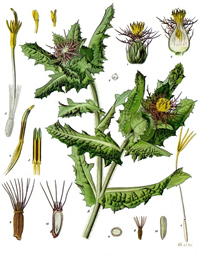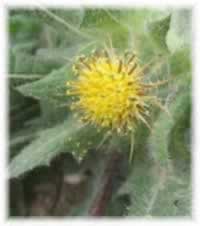Blessed Thistle Cnicus benedictus
- Common Names
- Blessed Thistle , Holy thistle, St. Benedict's thistle
- Botanical Name
- Cnicus benedictus
- Syn. Carbenia benedicta
- Family
- ASTERACEAE
Medicinal Uses & Benefits of Blessed Thistle
![]() How to Use|
Side Effects |
Plant & Garden|
How to Use|
Side Effects |
Plant & Garden|
- Medicinal Uses: * Cancer Prevention
* Digestion
* Female Hormones
* IBS
* Liver
* Pregnancy/Childbirth
- Properties: * Bitter * Cholagogue * Diaphoretic * Diuretic * Emmenagogue * Febrifuge * Galactagogue * Stimulant * Tonic
- Parts Used: Root, aerial parts and seeds
- Constituents: bitter compound (cnicine), alkaloids, mucilage, tannin, small amount of essential oil.
How to Use: Blessed Thistle
Blessed thistle is a bitter tonic, and as such is an excellent digestive herb to use as an apertif to prevent gas and bloating from eating a meal heavy in fats. Blessed thistle herb is also considered a depurative, having diuretic and diaphoretic properties; these actions help to purify the system and rid the body of toxins. Blessed thistle's medicinal actions help give support to the liver and help it to repair itself.
There is supporting research to suggest that blessed thistle has anti-tumor and anticancer effects. This adds another reason for those who are at risk for cancer to consider the use of blessed thistle as a tonic herb. 1,2
Blessed thistle is a traditional tonic for women. Dong quai and wild yam, along with other estrogenic herbs can be used in combination with blessed thistle to treat menstrual difficulties and other conditions where a woman's hormones need to be brought back into balance. One of the traditional uses for blessed thistle in herbal medicine is that of a galactagogue, an herb that stimulates a mothers milk.
Preparation Methods & Dosage :Traditionally taken as a tea, also used in extracts. Take a half cup hot, before heavy meals to aid digestion. It can also be applied externally as a poultice herb to treat chilblains.
Blessed Thistle Remedies
Blessed Thistle Side Effects: Large doses, such as more than five grams in a cup of tea may provoke vomiting. Not recommended for use for those with an ulcer, or during pregnancy
Plant Description

Koehler's Medicinal-Plants 1887
A handsome annual plant, thistle grows about 2 feet high, is reddish, slender, with pale yellow flowers.
Do not confuse blessed thistle with its cousin, milk thistle Cardus marianus, both thistles share the common name Holy thistle, along with many of the same properties and uses, but they are two entirely different plants, from different plant families.
History and Traditions & Folklore
Medieval monks held this plant in high esteem, as the name suggests and considered it a cure for everything from smallpox to headaches, being supposed to even cure the plague. It has been stated that the herb was first cultivated by Gerard in 1597, but as this book was published twenty years previously it would appear to have been in cultivation much earlier, and in fact is described in the Herbal of Turner in 1568. 3
- Duke, James A., Green Pharmacy Herbal Handbook(2000)
According to research, all parts of the plant show some ability to combat tumors. The active constituent, cinicin, cools inflammation, fights bacteria and reduces fluid retention
- NIH. (), National Cancer Institute
 . "Definition of Blessed Thistle."
. "Definition of Blessed Thistle."
Blessed thistle may have anti-inflammatory and anticancer effects. The scientific name is Cnicus benedictus. Also called cardin, holy thistle, spotted thistle, and St. Benedict's thistle.
- Grieve, Maud Mrs. "A Modern Herbal" (1931)












